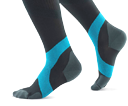| What Are Compression Socks?6 October 2015 | John Compression socks are a form of compression stocking, generally designed for more discrete use. Unlike compression stockings, compression socks only come in a below-knee style and are mostly aimed at men who need a compression garment but don’t feel comfortable wearing stockings. They’re designed to look like normal socks so men who need compression therapy can get the help they need without feeling self-conscious about wearing stockings. Compression socks come in a variety of different types and variations for different purposes: Compression SocksCompression Socks are general compression socks designed to treat a variety of conditions, including lymphoedema (a condition which causes a limb to swell) and varicose veins (a failure of valves in veins which causes blood to collect and veins to swell). As the majority of people with conditions which can be helped by compression don’t see much improvement from thigh-high stockings over knee-high stockings, compression socks can perform as good a job as needed. Sports Compression SocksThese compression socks are designed to help improve sports performance. One of the main benefits of compression garments is that they boost circulation, and when put into a sporting environment they have two major applications. It’s believed that if they’re worn during exercise involving your feet, sports compression stockings help to move lactic acid out of your calf muscles, so there’s less pain and you can keep going harder for longer. Also, some studies have shown that wearing sports compression socks after a workout or a run helps to improve muscle recovery and can reduce delayed onset muscle soreness, so you can recover easier than you would otherwise. Flight SocksFlight socks (also known as travel socks) are compression socks which provide light compression and help to reduce the risk of deep vein thrombosis (DVT) on long haul flights. DVT is where a vein deep in the body clots, and long haul passengers are considered to be more at risk for DVT in their legs because they’re inactive for a long period. By increasing the circulation, flight socks help to keep the blood flowing and reduce the risk of a blood clot forming in your legs. They even come recommended by the NHS as a way to help prevent DVT while travelling. Despite the name, flight or travel socks can be used on various modes of transport – if you feel uncomfortable on a long train or car ride, wearing travel socks may help to mitigate the problems. As with anything you’d use to treat a condition, you should consult with a doctor before using compression socks so you know that they’re right for you and you know exactly what strength you need. If you’re interested in getting your hands on some compression socks, head on over to Compression Stockings and check out our full range of Compression Socks. |







